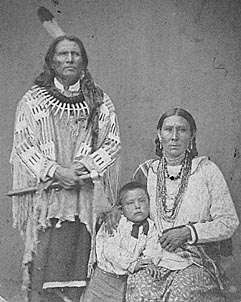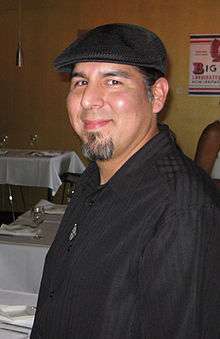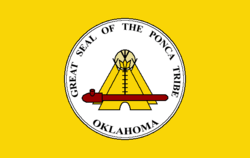Ponca Tribe of Indians of Oklahoma
|
Flag of the Ponca Tribe of Oklahoma | |
| Total population | |
|---|---|
| 3,581[1] | |
| Regions with significant populations | |
|
| |
| Languages | |
| Omaha-Ponca language, English | |
| Religion | |
| traditional tribal religion, Native American Church, Christianity | |
| Related ethnic groups | |
| Omaha, Otoe, Missouria, Ho-Chunk, Iowa, and other Siouan peoples |
The Ponca Tribe of Indians of Oklahoma, also known as the Ponca Nation, is one of two federally recognized tribes of Ponca people. The other is the Ponca Tribe of Nebraska. Traditionally, peoples of both tribes have spoken the Omaha-Ponca language, part of the Siouan language family.
Under the Department of Interior's Land Buy-Back Program for Tribal Nations, more than 1300 holders of fractional interests at this tribe were offered a total of $7 million to purchase holdings for transfer to the tribe, to increase their communal lands.
Government
The Ponca Tribe of Indians of Oklahoma is headquartered in Ponca City, Oklahoma. Their tribal jurisdictional area includes parts of Kay and Noble counties. Of the 3,581 enrolled tribal members, 3000 live within the state of Oklahoma. Membership in the tribe requires a 1/8 minimum blood quantum, according to rules developed by the tribe.[1]
Current administration
According to their written constitution, the seven-member governing council of the Ponca Tribe, called the Business Committee, is democratically elected for four-year terms. Among these, one person is elected as chairman. Other offices include vice-chairman, and secretary/treasurer.
The current tribal administration includes:
- Earl "Trey" Howe III, Chairman[2]
- Bennett Arkeketa, Vice-Chairman[3]
- Paula Mendoza, Secretary/Treasurer
- Kinsel Lieb, Business Committee Member
- Douglas Eagle, Sr., Business Committee Member
- Casey Camp-Horinek, Business Committee Member
- Doug Rhodd, Sr., Business Committee Member
Economic development
The Ponca Indian Tribe operates its own housing authority and issues its own tribal vehicle tags. Their tribal jurisdiction is relatively isolated and they have worked to create jobs for their people.
They developed a casino in Ponca City, their major jurisdiction. It is more than 105 miles north of Oklahoma City by car, and about 94 miles northwest of Tulsa, two major population centers. The Blue Star Gaming and Casino has ceased operations.[4] The Ponca opened a second casino in the same location, called the Two Rivers Casino; it also went out of business in the economic downturn due to the national recession in 2008-2009. The tribe was severely affected by this. The estimated annual economic impact of the Ponca Tribe in 2011 was $1,964,321, down from $15 million in 2008,[1] when the casino was operating.
Language and culture
In 2009 an estimated 33 tribal members spoke the Ponca language.[5]
Since 1876 the tribe hosts an annual homecoming powwow. It takes place in August in Ponca City.[6]
History


The Ponca tribe separated from the Omaha tribe in the early 18th century as they were migrating west from the Great Lakes region. They settled in present-day Nebraska and South Dakota. Smallpox and other introduced Eurasian diseases took a heavy toll of the tribe repeatedly in the 18th and 19th centuries, as they had no immunity to the new diseases. The more powerful Sioux, also known as the Lakota, encroached on their land base.
The Ponca never went to war with the United States. They signed their first peace treaty with the US in 1817. In the 1825 they signed a trade agreement. Treaties in 1858 and 1865 ceded lands. The 1860s and 1870s were a difficult time for the Ponca tribe, as the buffalo were disappearing, droughts destroyed crops, and warfare with the Sioux combined to threaten the Ponca with starvation.[8]
The US did not uphold their treaty obligations to the Ponca. They gave land reserved for the Ponca to the Sioux in 1868, as part of the Great Sioux Reservation. The government relocated the Ponca to Indian Territory in 1877.[8]
The forced removal of the Ponca to Indian Territory was mismanaged; they arrived too late to plant crops, the government failed to provide them with adequate supplies, and their assigned location had chronic malaria. An estimated 158 Ponca died during the first year: almost a third of the entire tribe. Among them was the oldest son of Standing Bear, a Ponca chief.
Standing Bear took his son's body back to Nebraska for burial in traditional lands. There he was arrested by the Army for having left the reservation, but he gained the sympathy of Brigadier General George Crook. With help from prominent attorneys working pro bono, Standing Bear filed a habeas corpus suit challenging his arrest. The US District Court judge's decision in Standing Bear v. Crook (1879) established the right of Indian people to exercise habeas corpus and their legal status as citizens under US law.[8]
White Eagle, a principal Ponca chief, settled on a 101,000-acre (410 km2) reservation in what would later be organized as Kay and Noble counties in Oklahoma. He leased much of the land to the 101 Ranch for pasture (and later, oil development). In the 1890s missionaries and government agents tried to make the Ponca abandon their traditional tribal dances and lifeways.
In 1892, under the Dawes Allotment Act, the US government registered the members of the tribe, and allocated individual plots of land to each household. This was intended to introduce them to fee ownership and subsistence farming, as well as extinguish Indian tribal land claims in Oklahoma prior to its becoming a state. The government declared the remaining reservation land as "surplus" and sold it to European-American settlers. This resulted in a great loss of communal land for the tribe and its descendants, and destabilized their traditional culture.
20th century to present
The discovery of oil on Ponca lands in 1911 had mixed results for the people. Some became wealthy but others were taken advantage of by speculators and quickly lost their land. Drilling and exploitation of oil, together with mining of other resources, created environmental problems for the tribe.[8]
Peyote religion was introduced in the 1910s. In 1918, Louis MacDonald and Frank Eagle, both Ponca, co-founded the Native American Church.[8]
After many Ponca served in World War I, returning Ponca veterans founded the American Legion chapter Buffalo Post 38. In their community they revived traditional war dances, such as the heluska dance.[8]
Under the 1936 Oklahoma Indian Welfare Act, the tribe reorganized their government. They ratified their constitution in 1950 and became federally recognized. Tribal headquarters were established in White Eagle, located south of Ponca City.[8]
Clyde Warrior, a Ponca, cofounded the National Indian Youth Council. He promoted self-determination and inspired many young Native activists during the 1960s and 1970s.[8]
In the years since allocation of plots under the Dawes Act, these landholdings and interests became highly fractionated among heirs, often preventing effective use of the land and making sales difficult. In addition, the departments of Interior and Treasury were found in the late 20th century to have mismanaged the fee accounts and payments due to holders of fractionated land for drilling and mineral leases. In 2009 the US government settled a major class action suit against it brought by Elouise Cobell (Blackfeet) in 1996, known as the Cobell v. Salazar suit.
The Ponca are participating in the Department of Interior's Land Buy-Back Program for Tribal Nations, developed as part of this settlement. In August 2016, Interior officials announced that it had offered approximately $7 million in purchase offers to "more than 1,300 landowners with fractional interests at the Ponca Tribe of Indians of Oklahoma" as part of the Land Buy-Back Program for Tribal Nations (Buy-Back Program). Recipients have 45 days to complete the transaction. This program is designed to purchase fractionated interests and transfer land back to tribes in trust, to increase their communal holdings and ability to better use the land.[9]
Notes
- 1 2 3 2011 Oklahoma Indian Nations Pocket Pictorial Directory. Oklahoma Indian Affairs Commission. 2011: 29. Retrieved 28 Jan 2012.
- ↑ Chairman. The Official Website of the Ponca Tribe of Oklahoma. (retrieved 6 August 2009)
- ↑ Vice-Chairman. The Official Website of the Ponca Tribe of Oklahoma. (retrieved 6 August 2009)
- ↑ Oklahoma Indian Casinos: Casinos by Tribe.500 Nations. Retrieved 2 Jan 2011.
- ↑ Anderton, Alice, PhD. Status of Indian Languages in Oklahoma. Intertribal Wordpath Society. 2009 (6 August 2009)
- ↑ Ponca Nation. The Official Website of the Ponca Tribe of Oklahoma. (retrieved 6 August 2009)
- ↑ "Urban Indian 5." US Department of the Interior, Indian Arts and Crafts Board. (retrieved 15 Oct 2011)
- 1 2 3 4 5 6 7 8 Van de Logt, Mark. "Ponca", Oklahoma Historical Society's Encyclopedia of Oklahoma History & Culture. 2009 (6 August 2009)
- ↑ "More than $7 Million in Buy-Back Offers Sent to Landowners with Fractional Interests at Ponca Tribe of Indians of Oklahoma", Press Release, 18 August 2016, Department of Interior; accessed 26 November 2016
External links
| Wikimedia Commons has media related to Ponca. |
- Ponca Tribe of Oklahoma, official website
- Constitution of the Ponca Tribe of Indians
- "Ponca", Oklahoma Historical Society's Encyclopedia of Oklahoma History and Culture
